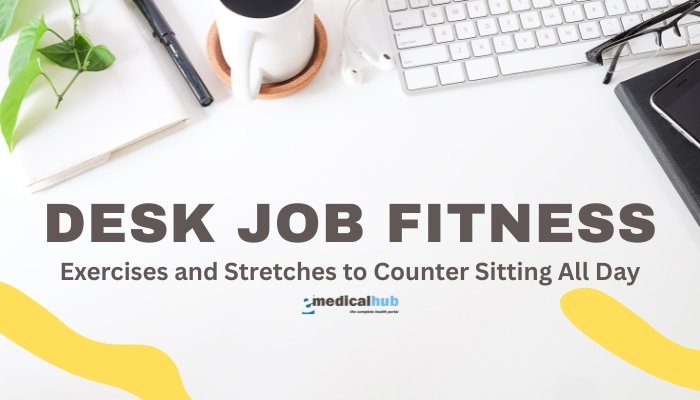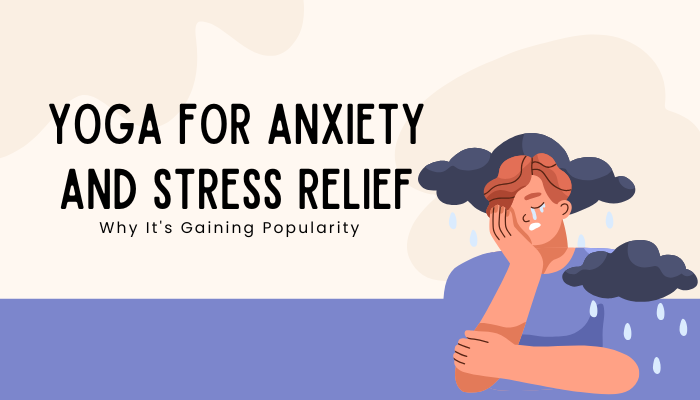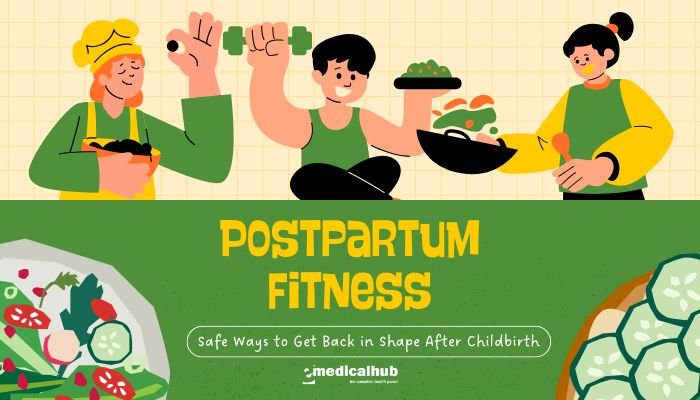Introduction
Many modern jobs require long hours at a desk, leaving little time for physical activity. Prolonged sitting can lead to muscle stiffness, poor posture, reduced circulation, and an increased risk of chronic diseases. Incorporating simple exercises and stretches into your workday can counter these negative effects. This article explains the health risks of sitting too much, provides a range of desk-friendly exercises and stretches, and offers practical tips to build a routine that keeps you active—even during busy workdays.
Disclaimer: This content is for educational purposes only and does not replace personalized medical or fitness advice. If you have any health conditions or injuries, consult a healthcare provider before starting a new exercise routine.
The Impact of Prolonged Sitting
Health Risks Associated with Sedentary Behavior
Extended periods of sitting have been linked to several health problems:
- Musculoskeletal Issues: Tight hip flexors, weakened core, and lower back pain are common.
- Poor Circulation: Prolonged sitting can reduce blood flow in the legs, increasing the risk of deep vein thrombosis.
- Metabolic Problems: Inactivity is associated with a higher risk of obesity, type 2 diabetes, and cardiovascular disease.
- Posture Degradation: Slouched or hunched posture over time may lead to chronic pain in the neck and shoulders.
- Mental Health Impact: Lack of movement may contribute to feelings of sluggishness and lower mood.
The Importance of Breaking Up Sitting Time
Interrupting long periods of sitting with movement:
- Increases energy expenditure.
- Improves blood flow.
- Helps maintain joint mobility and muscle strength.
- Can boost concentration and reduce stress.
Desk-Friendly Exercises
Integrating exercises that you can perform at or near your desk is key to counteracting the effects of prolonged sitting.
Seated Exercises
These exercises can be done without leaving your chair.
Seated Leg Raises
- How to Do It: Sit up straight with your feet flat on the floor. Extend one leg straight out and hold for a few seconds, then lower it slowly. Repeat with the other leg.
- Benefits: Strengthens the quadriceps and improves circulation in the lower body.
Seated Marches
- How to Do It: While seated, lift one knee toward your chest, lower it, and then lift the opposite knee. Continue alternating.
- Benefits: Activates core and leg muscles and improves lower body circulation.
Seated Torso Twists
- How to Do It: Sit upright with your feet flat on the floor. Twist your torso slowly to one side, hold for a few seconds, and return to center. Repeat on the other side.
- Benefits: Enhances spinal mobility and reduces lower back stiffness.
Seated Shoulder Rolls
- How to Do It: Sit with your back straight. Slowly roll your shoulders forward in a circular motion, then reverse direction.
- Benefits: Relieves shoulder tension and promotes better posture.
Standing Exercises at Your Desk
If your workspace allows, these exercises can be done standing up.
Desk Push-Ups
- How to Do It: Stand an arm’s length from your desk. Place your hands on the desk and perform push-ups by lowering your chest toward the desk, then pushing back up.
- Benefits: Strengthens the chest, shoulders, and arms while engaging core muscles.
Wall Sits
- How to Do It: Stand with your back against a wall. Slide down until your thighs are parallel to the floor and hold the position for 30-60 seconds.
- Benefits: Builds strength and endurance in the legs and glutes.
Standing Calf Raises
- How to Do It: Stand with your feet shoulder-width apart. Slowly rise onto your toes, hold for a moment, and then lower back down.
- Benefits: Strengthens the calf muscles and improves balance.
Desk Squats
- How to Do It: Stand in front of your desk with your feet shoulder-width apart. Lower your body as if sitting in a chair until you lightly touch the desk, then stand back up.
- Benefits: Engages the lower body and core while promoting functional movement.
Desk Stretches to Improve Flexibility
Regular stretching can help reduce muscle tightness and improve posture.
Neck and Shoulder Stretches
Neck Stretch
- How to Do It: Sit or stand with a straight back. Gently tilt your head to one side, bringing your ear toward your shoulder, and hold for 15-30 seconds. Repeat on the other side.
- Benefits: Relieves tension in the neck and reduces stiffness.
Shoulder Shrugs and Rolls
- How to Do It: Lift your shoulders toward your ears, hold for 2 seconds, then release. Perform 10-15 repetitions. Follow with slow shoulder rolls.
- Benefits: Loosens tight shoulder muscles and improves circulation.
Back and Torso Stretches
Seated Spinal Twist
- How to Do It: Sit on the edge of your chair, feet flat on the floor. Place your right hand on the back of the chair and twist your torso to the right. Hold for 15-30 seconds, then repeat on the left side.
- Benefits: Increases spinal mobility and alleviates lower back tension.
Cat-Cow Stretch (Modified for Desk)
- How to Do It: Sit upright with your hands on your knees. On an inhale, arch your back and lift your chest (Cow). On an exhale, round your spine and tuck your chin (Cat). Repeat for 1-2 minutes.
- Benefits: Promotes flexibility in the spine and reduces back stiffness.
Lower Body Stretches
Seated Hamstring Stretch
- How to Do It: Sit on the edge of your chair with one leg extended and the heel on the floor. Lean forward slowly to feel a stretch in the back of your thigh. Hold for 15-30 seconds and switch legs.
- Benefits: Enhances flexibility in the hamstrings and lower back.
Calf Stretch Against the Wall
- How to Do It: Stand facing a wall. Place your hands on the wall and step one foot back, keeping it straight and the heel on the ground. Lean forward gently until you feel a stretch in your calf. Hold for 15-30 seconds, then switch legs.
- Benefits: Increases calf flexibility and improves ankle mobility.
Incorporating Movement Breaks into Your Workday
The Importance of Micro-Breaks
Sitting for long periods can be harmful. Micro-breaks—short breaks to stand up and move—can make a big difference:
- Improved Circulation: Frequent movement promotes blood flow and reduces the risk of circulatory problems.
- Reduced Muscle Stiffness: Breaking up long periods of sitting helps prevent muscle tightness.
- Mental Refreshment: Short breaks can boost concentration and reduce stress.
Practical Ways to Integrate Movement
- Set a Timer: Every 30-60 minutes, stand up, stretch, or walk for 2-5 minutes.
- Walking Meetings: When possible, conduct meetings while walking.
- Active Phone Calls: Take calls standing or pacing instead of sitting.
- Desk Exercises: Perform simple seated exercises, like leg lifts or shoulder rolls, during brief breaks.
Creating a Personalized Desk Job Fitness Routine
Assess Your Needs and Limitations
- Identify Pain Points: Note which areas feel tight or sore (e.g., neck, lower back, shoulders).
- Adjust for Mobility: Modify exercises and stretches if you have joint pain or limited movement.
- Set Achievable Goals: Start with short sessions and gradually increase the duration and intensity as you adapt.
Sample Daily Routine
Morning Routine (Before Work) – 10 Minutes
- Neck stretches: 2 minutes (side-to-side, front-to-back).
- Shoulder shrugs and rolls: 2 minutes.
- Gentle torso twists: 2 minutes.
- Seated hamstring stretch: 2 minutes (1 minute per leg).
- Deep breathing and mindful posture check: 2 minutes.
Midday Break (During Work) – 5 Minutes
- Stand up and perform 10 desk push-ups.
- Walk around your office or home for 3-5 minutes.
- Do 10-15 seated leg raises.
- Quick shoulder and neck rolls.
Afternoon Session (After Work) – 10-15 Minutes
- Brisk walk or light jogging outside or in place.
- Incorporate dynamic stretches such as leg swings and arm circles (3 minutes).
- Perform 5-10 minutes of yoga-based stretching (cat-cow, seated twist, child’s pose).
- Cool down with deep breathing for 2 minutes.
Weekly Planning
Aim to integrate these routines daily and combine them with longer exercise sessions on off-days:
- Daily Micro-Breaks: Consistently interrupt long sitting periods with movement.
- Combined Sessions: On days when possible, supplement with a 30-minute walk or workout.
- Flexibility and Strength: Alternate between stretching-focused sessions and gentle strength exercises to maintain overall fitness.
Ergonomics and Posture: Enhancing Desk Job Fitness
Setting Up an Ergonomic Workspace
A well-arranged workstation reduces strain and supports movement:
- Chair: Choose a chair that supports the natural curve of your spine, with adjustable height and lumbar support.
- Desk Height: Ensure your desk allows your elbows to be at a 90-degree angle while typing.
- Monitor Position: The top of your monitor should be at or slightly below eye level to avoid neck strain.
- Keyboard and Mouse: Position them to allow relaxed shoulder positioning and neutral wrist posture.
Maintaining Good Posture Throughout the Day
- Sit Upright: Keep your back straight, shoulders relaxed, and feet flat on the floor.
- Regular Posture Checks: Use reminders or apps to prompt you to adjust your posture if you notice yourself slumping.
- Standing Desks: If available, alternate between sitting and standing to promote movement and reduce stiffness.
The Role of Mindfulness in Desk Job Fitness
Enhancing Focus and Reducing Stress
Mindfulness practices can further enhance the benefits of movement:
- Mindful Breathing: Take a few deep, slow breaths during breaks to lower stress.
- Body Scan: Periodically check in with your body to identify tension and adjust your posture.
- Meditative Movement: Integrate simple yoga poses or mindful walking into your day to boost mental clarity.
Integrating Mindfulness with Movement
- Combine Stretching with Meditation: Focus on each movement and stretch, noting sensations in your muscles.
- Mindful Breaks: Instead of rushing through breaks, take a moment to appreciate your progress and reset your mind.
Real-World Examples and Success Stories
Office Worker Transformation
Maria, a 42-year-old office worker, struggled with chronic neck and lower back pain due to long hours at her desk. By incorporating a structured routine of seated stretches, micro-breaks, and brief walks during her workday, she experienced:
- Reduced pain and improved posture.
- Enhanced energy levels and focus.
- A gradual increase in daily step count and overall fitness.
Remote Worker’s Routine
John, who works from home, found that setting a timer for 30-minute intervals helped him break up his day. He used his breaks for quick yoga stretches and a brisk walk around his neighborhood. Over time, he reported:
- Better sleep quality.
- Increased productivity.
- A noticeable improvement in his mood and reduced stress.
Senior Professional’s Adaptation
Linda, a 65-year-old retired teacher now working part-time, began experiencing stiffness and reduced mobility. With modifications to her daily routine—including gentle stretching, seated exercises, and regular walks—she:
- Improved her balance and flexibility.
- Reduced her risk of falls.
- Enjoyed increased social interaction during group walks at her local park.
Frequently Asked Questions (FAQ)
- How often should I take breaks if I have a desk job?
Aim to take a short movement break every 30-60 minutes. Even a 2-5 minute break can help reduce muscle stiffness and improve circulation. - Can I do these exercises at my desk without disrupting my work?
Yes. Many exercises and stretches are discreet and can be performed in a small space. Seated stretches or a quick stand-up walk are usually easy to integrate into your work routine. - What if I have limited mobility or chronic pain?
Consult a healthcare provider or physical therapist to tailor exercises to your needs. Chair-based exercises and gentle stretches can be very effective and safe for those with mobility challenges. - Do I need any special equipment?
Most desk-friendly exercises require little or no equipment. A comfortable chair, proper footwear, and a small open space are usually sufficient. Resistance bands or a stability ball can add variety if desired. - Can posture adjustments alone reduce discomfort?
Yes. An ergonomic setup and regular posture checks can significantly reduce discomfort. Combining these with movement breaks and stretching further enhances the benefits. - Are standing desks beneficial for reducing the effects of prolonged sitting?
Standing desks help reduce sedentary time, but it’s important to alternate between sitting and standing. The key is to change positions frequently rather than standing continuously. - How do I measure progress?
You can track progress by monitoring improvements in posture, reductions in pain or stiffness, increased energy, and, if desired, using a fitness tracker to record step counts and activity levels. - Can mindfulness techniques enhance the benefits of these exercises?
Absolutely. Mindfulness can help you focus on your body’s signals, reduce stress, and make your exercise breaks more effective. Simple mindful breathing during stretches can enhance relaxation. - What are some simple desk exercises to start with?
Begin with seated leg raises, neck and shoulder stretches, seated torso twists, and desk push-ups. These are low-impact and easy to perform without special equipment. - How do I prevent overuse injuries from repetitive desk exercises?
Vary your exercises throughout the day and week. Incorporate different movements, take regular breaks, and listen to your body to avoid excessive repetition. - Is it better to do a long stretching session or multiple short breaks throughout the day?
Both can be effective. Short, frequent breaks help counteract the negative effects of prolonged sitting, while a longer session can provide deeper stretches and relaxation. Combining both approaches often yields the best results. - How does regular movement impact overall energy levels?
Regular movement increases circulation and oxygen flow, which can boost energy levels, reduce fatigue, and improve cognitive focus throughout the day.
Conclusion
Sitting for long hours can take a toll on your body, but with a few simple exercises and stretches, you can significantly counter these effects. Incorporating movement breaks, desk-friendly exercises, and mindful stretches into your workday can help improve circulation, reduce muscle stiffness, and enhance overall physical and mental well-being. Whether you’re an office worker, a remote professional, or anyone with a sedentary job, developing a personalized routine that fits your lifestyle is key to maintaining long-term health.
Remember that even small amounts of movement can add up to significant health benefits. Focus on consistency, adjust your routine to your specific needs, and combine these exercises with proper ergonomics and mindfulness practices. By taking control of your daily movement, you not only protect your body from the negative effects of prolonged sitting but also pave the way for a more active, energetic, and balanced life.
References
- Straker L, Mathiassen SE. Increased physical work demands in modern work: the importance of evidence-based practice in physical activity interventions. Ergonomics. 2009;52(7):882-891.
- Thorp AA, Owen N, Neuhaus M, Dunstan DW. Sedentary behaviors and subsequent health outcomes in adults. Am J Prev Med. 2011;41(2):207-215.
- Tremblay MS, Aubert S, Barnes JD, et al. Sedentary Behavior Research Network (SBRN) – Terminology Consensus Project process and outcome. Int J Behav Nutr Phys Act. 2017;14(1):75.
- Dunstan DW, Howard B, Healy GN, Owen N. Too much sitting – A health hazard. Diabetes Res Clin Pract. 2012;97(3):368-376.
- Lee I-M, Shiroma EJ, Lobelo F, et al. Effect of physical inactivity on major non-communicable diseases worldwide: an analysis of burden of disease and life expectancy. Lancet. 2012;380(9838):219-229.
- Tucker JM. Exercise and recovery: the effects of intermittent movement. Sports Med. 2017;47(3):567-575.
- O’Connell NE, et al. The efficacy of workplace interventions to promote physical activity: a systematic review. Prev Med. 2019;121:101-115.
- Conn VS, Hafdahl AR, Cooper PS, et al. Meta-analysis of workplace physical activity interventions. Am J Health Promot. 2009;23(1):116-129.
- Sallis JF, et al. The benefits of physical activity for older adults. J Aging Phys Act. 2016;24(2):221-227.
- U.S. Department of Health and Human Services. Physical Activity Guidelines for Americans, 2nd Edition. 2018.
- McPhee JS, et al. Physical activity and the aging process: a critical review. J Aging Health. 2018;30(7):1015-1030.
- American College of Sports Medicine. ACSM’s Guidelines for Exercise Testing and Prescription. 10th ed. Philadelphia, PA: Wolters Kluwer; 2018.




